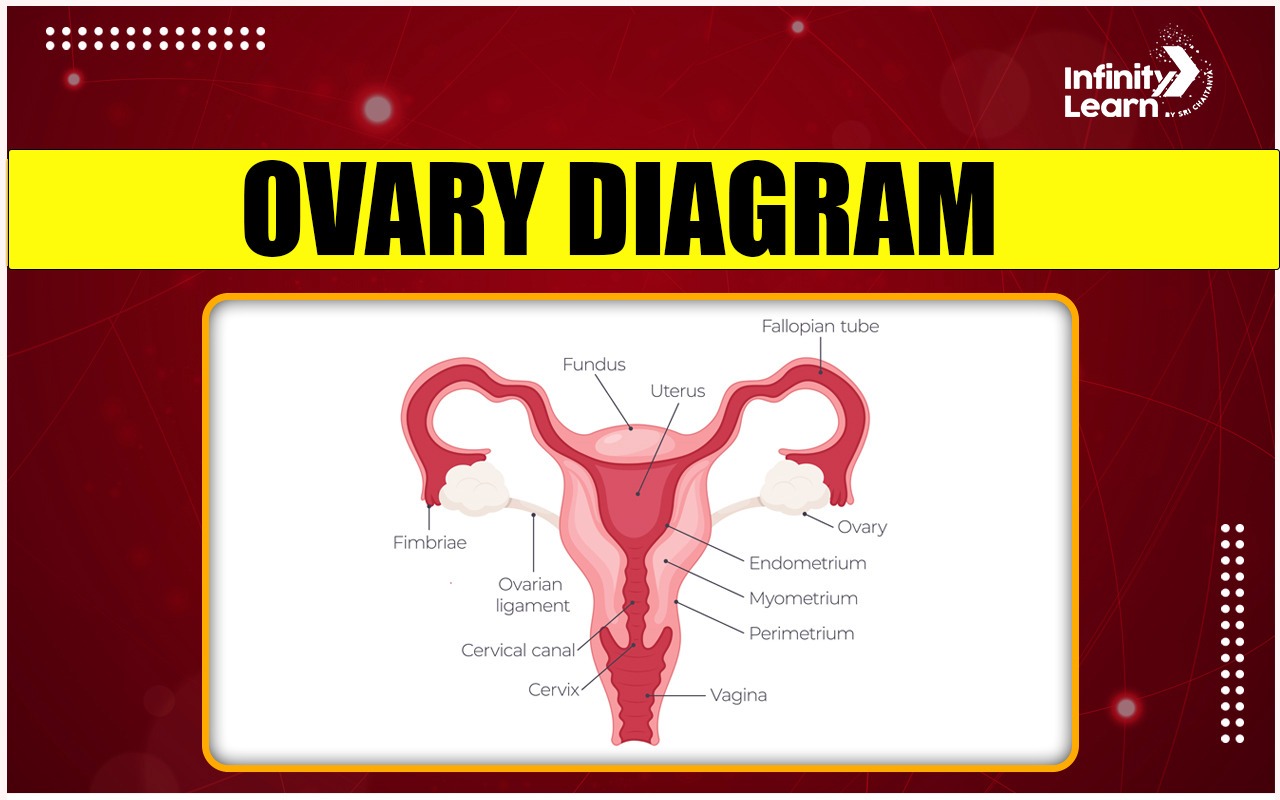Table of Contents
The ovary is a key part of the female reproductive system. It creates eggs, also known as ova, which are not able to move on their own. When a moving sperm cell fertilizes an egg, they form a zygote. Additionally, the ovaries function as endocrine glands, releasing hormones in females. Let’s take a look at the structure of an ovary with a detailed diagram.
Ovary Diagram

Anatomy of the Ovary
The ovary is found in the pelvic region, close to the uterus. Its main job is to produce and release eggs for possible fertilization. The ovary has two parts: the outer layer, called the cortex, and the inner part, known as the medulla. In the cortex, there are structures called ovarian follicles where eggs grow. Blood vessels and lymphatic vessels provide the ov with nutrients and oxygen and help get rid of waste. This is the basic structure of the ovary.
Location and Structure
- Location: The ovaries are two small, almond-shaped organs located on either side of the uterus, in the lower abdomen.
- Size: Each ovary is about the size of an almond.
- Main Parts of the Ovary
Cortex:
- The outer layer of the ovary.
- Contains tiny sacs called follicles, each holding an immature egg (oocyte).
- As the egg matures, the follicle grows and moves to the surface of the ovary.
Medulla:
- The inner part of the ovary.
- Contains blood vessels, nerves, and connective tissue.
- Provides nourishment and support to the ovary.
Functions of the Ovary
Egg Production:
- Every month, one of the ovaries releases a mature egg, a process known as ovulation.
- The egg travels through the fallopian tube towards the uterus.
Hormone Production:
- Ovaries produce female hormones, mainly estrogen and progesterone.
- These hormones regulate the menstrual cycle, pregnancy, and secondary sexual characteristics like breast development.
Role of Ovary in the Menstrual Cycle
The ovary plays a key role in the menstrual cycle, which is important for reproduction and fertility. The cycle includes several main stages:
Follicular Phase: This phase starts the menstrual cycle. Ovarian follicles grow with the help of follicle-stimulating hormone (FSH). The growing follicles produce estrogen, which helps thicken the uterine lining.
Ovulation: Around the middle of the cycle, a surge in luteinizing hormone (LH) causes ovulation. During this process, a mature egg is released from the ovary into the fallopian tube, where it can meet sperm and be fertilized.
Luteal Phase: After ovulation, the leftover follicle turns into the corpus luteum, which produces progesterone. Progesterone keeps the uterine lining thick, ready for a possible embryo. If pregnancy doesn’t happen, the corpus luteum breaks down, hormone levels drop, and menstruation starts, beginning a new cycle.
Life Stages and the Ovaries
Puberty: Ovaries start to release eggs and produce hormones, leading to menstruation.
Reproductive Years: Ovaries continue to release eggs monthly and produce hormones regularly.
Menopause: Ovaries gradually stop releasing eggs and hormone levels decrease, ending the menstrual cycle.
Common Conditions Related to the Ovaries
Ovarian Cysts:
- Fluid-filled sacs that can form on the ovaries.
- Usually harmless but can cause pain or discomfort if they grow large.
Polycystic Ovary Syndrome (PCOS):
- A condition where many small cysts form on the ovaries.
- Can cause irregular periods, weight gain, and infertility.
Ovarian Cancer:
- A rare but serious condition where cancer cells grow in the ovaries.
- Early detection is crucial for effective treatment.
Ovary Diagram FAQs
Where is the ovary in the human body?
The ovary is located in the lower abdomen on each side of the uterus.
What is the structure of the human ovary?
The human ovary is a small, oval-shaped organ with a surface layer, cortex, medulla, and hilum.
How many ovaries are in a female?
A female typically has two ovaries.
What is the ovary in plant class 10?
In plants, the ovary is the part of the flower that contains the ovules and develops into fruit after fertilization.
What is an ovary of a flower?
The ovary of a flower is the part that holds the ovules and becomes the fruit after fertilization.
What is the ovary in biology?
In biology, the ovary is the female reproductive organ that produces eggs and hormones.
What are the four layers of the ovary?
The four layers of the ovary are the germinal epithelium, cortex, medulla, and hilum.
Where is the ovary located?
The ovary is located in the lower abdomen on either side of the uterus.
What is the ovary in a short note?
The ovary is a female reproductive organ that produces eggs and hormones and plays a key role in the menstrual cycle and fertility.
What are the four layers of the ovary?
The four layers are the germinal epithelium, cortex, medulla, and hilum.
Where is the ovary located?
The ovary is located in the lower abdomen on either side of the uterus.
What is the ovary in a short note?
The ovary is a small, oval-shaped female reproductive organ that produces eggs and hormones.









